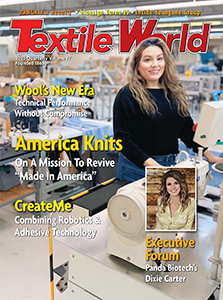Yesterday, a very special and unique event happened in Schwäbisch Hall, Germany. Wilhelm Christ,
the inventor of the Airflow® technology, and for many years research director at Germany-based Then
Maschinen GmbH, received a medal from the State of Baden-Wurttemberg for his merits regarding
economy and technology for the state.
The engineer started his new invention in the late 1970s when the dyeing of a kilogram (kg)
of fabric required about 150 liters of water. This challenged Christ, head of the Then research
department, to question how the enormous water and energy demand in fabric dyeing could be lowered.
In those days, the traditional machinery used water to carry dyes and also to drive the fabric,
which resulted in the very high water consumption.
In 1979, Christ began to develop the Airflow technology with Germany-based Hoechst AG. The
idea was to replace the fabric transport medium, using steam instead of water, whereby the
steam-heated dye liquor was injected into an air-jet nozzle. The next challenge was to efficiently
distribute the small amounts of dye liquor and auxiliaries onto the fabric.
After this revolutionary idea was realized on a piece of paper, things accelerated rapidly.
In 1981, the basic Airflow patent was registered to Christ, Dr. Hans Ulrich von der Eltz and Albert
Reuther. The European patent followed in 1982. At the same time, the application of the process
started in many countries worldwide.
One year later in Milan, the first Airflow machine was shown at ITMA ‘83. This machine
received skeptical reactions from the so-called world experts. However, the first 10-kg load-size
prototype machine was installed at Hoechst’s application laboratory. Subsequently, Then introduced
the Airflow technology commercially and started its successful journey.
A great honor was awarded to Christ on Sept. 16, 1996, when he received the Henry E. Millson
Award for Invention from Frederick K. Jones, president of the American Association of Textile
Chemists & Colorists.
The rest is history. In today’s world of environmental consciousness, the Airflow technology
is more than a technical advantage. It saves a lot of water, energy and dyestuff — and last, but
not least, labor costs.
Ernst Pfister, minister of Economic Affairs of the State of Baden-Wurttemberg, recognized in
his laudation the achievements of a person, who, at the age of 83, is still full of energy and
ideas. And still today, Christ is working as a research associate at Then.
Bill Fong, executive director of Then’s parent company, Fong’s Group, and managing director
of Then, said in his speech that today, to maintain a leading position, one must provide innovative
products and solutions to its customers. And, as a matter of fact, all companies are faced with a
great demand from their customers for more environmentally friendly solutions for the industry.
So, that’s why today, it is not just about being a so-called “socially or environmentally
conscious company, but because of the ever-rising costs of various natural resources and
commodities from energy to base metals and water, being an environmentally conscious company also
means being a profitable company.
And, with a smile to Christ, Fong said: “Your invention of the Airflow technology was clearly
before its time, as it is only now, more than two decades later, that the textile industry
worldwide truly appreciates the benefits brought by the Airflow technology in terms of the
important savings in energy, water and chemical consumption. This is to your own, personal merit.”
February 26, 2008




